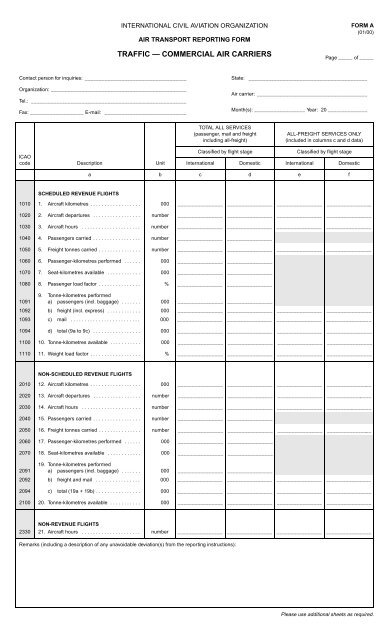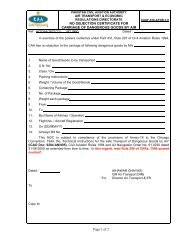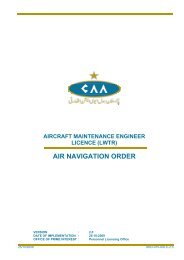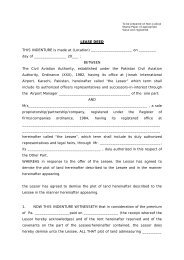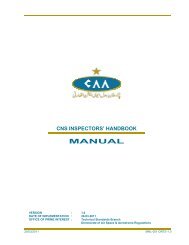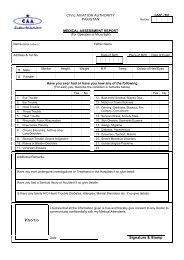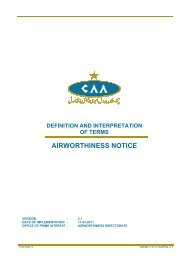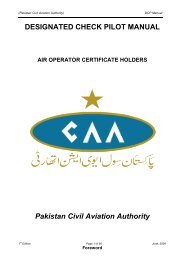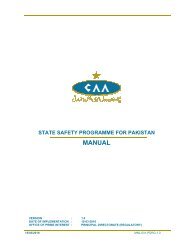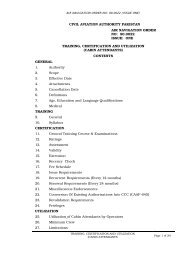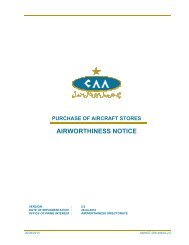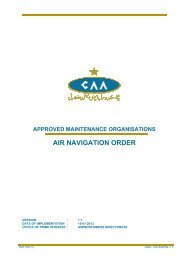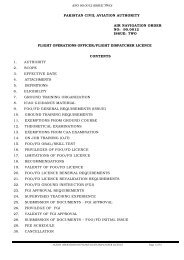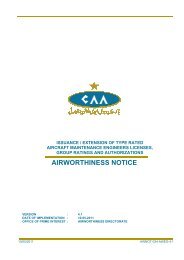Create successful ePaper yourself
Turn your PDF publications into a flip-book with our unique Google optimized e-Paper software.
PAGE 2REPORTING INSTRUCTIONSNon-revenue flights. Report under this heading aircraft hours flown on test flights, training and all otherflights for which no revenue is received.Columns c through f. The statistics to be reported in Columns c through f are classified as eitherinternational or domestic in accordance with the flight stage category (see definitions below). Theclassification of traffic (passengers, freight, mail), irrespective of its nature, shall be identical to theclassification of the flight stage flown by the aircraft.International (Columns c and e). Data for these columns are to be computed from all international flightstages performed during the reporting period.Domestic (Columns d and f). Data for these columns are to be computed from all domestic flight stagesperformed during the period.Total all services (Columns c and d). All air services performed by an air carrier are to be reported inthese columns, including all-freight services. Any surface transportation of passengers and freight arrangedby an air carrier in connection with an air journey should not be included in the data.All-freight services only (Columns e and f). These columns are to be completed for all air carriers thatoperate all-freight services. Report under this heading data concerning scheduled and non-scheduled flightsperformed by aircraft carrying loads other than passengers, i.e. freight, unaccompanied baggage, mail.Exclude all flights carrying one or more revenue passengers, and flights listed in schedules as providing anypassenger service. Data reported for “All-freight services only” must also be included as part of the “Totalall services” figures in Columns c and d.RowsAircraft kilometres (Items 1, 12). Enter the sum of the products obtained by multiplying the number ofrevenue flight stages flown by the corresponding stage distance.Aircraft departures (Items 2, 13). Enter the number of landings made or flight stages flown.Aircraft hours (Items 3, 14, 21). Aircraft hours are to be reported to the nearest hour and to be based on“block-to-block” time (i.e. from the moment the aircraft is pushed back from the gate or starts taxiing fromits parking stand for take-off to the moment it comes to a final stop at a gate or parking stand after landing).If a different basis is used, indicate this under “Remarks.”Passengers carried (Items 4, 15). The number of revenue passengers carried (see definition below) shouldbe obtained by counting each passenger on a particular flight (one that has the same flight numberthroughout the journey of the passenger) only once and not at each individual stage of that flight, with thesingle exception that a passenger flying on both the international and domestic stages of the same flightshould be counted as both a domestic and an international passenger. Non-revenue passengers should beexcluded.Freight tonnes carried (Items 5, 16). The number of revenue freight tonnes carried should be obtained bycounting each tonne of freight on a particular flight (one that has the same flight number throughout the tripof the shipment) only once and not at each individual stage of that flight, with the single exception that freightflown on both the international and domestic stages of the same flight should be counted as both a domesticand an international shipment.Passenger-kilometres performed (Items 6, 17). Enter the sum of the products obtained by multiplying thenumber of revenue passengers carried on each flight stage by the corresponding stage distance. Theresultant figure is equal to the number of kilometres travelled by all passengers.Seat-kilometres available (Items 7, 18). Enter the sum of the products obtained by multiplying the numberof passenger-seats available for sale on each flight stage by the corresponding stage distance. Seats notactually available for the carriage of passengers because of the weight of fuel or other load should beexcluded from the calculations.Passenger load factor (Item 8). Enter the passenger-kilometres (Item 6) expressed as a percentage ofseat-kilometres available (Item 7). Report the passenger load factor to one decimal (i.e. the nearest tenthof a percentage point).Tonne-kilometres performed (Items 9, 19). Enter the sum of the products obtained by multiplying thenumber of tonnes of revenue load (i.e. one for which remuneration is received) carried on each flight stageby the corresponding stage distance. Separate calculations should be made for:FORM ATRAFFIC — COMMERCIAL AIR CARRIERS
REPORTING INSTRUCTIONS PAGE 3Passengers (Items 9 a), 19 a)). Normal baggage allowance and excess baggage should be includedhere. To convert aircraft passenger loads into weight loads, the number of passengers carried ismultiplied by a factor representing the average weight of the passenger plus both normal baggageallowance and excess baggage. This conversion factor is left to the discretion of the operator. However,if no conversion factor is available, it is recommended that 90 kilograms be used.Freight (Item 9 b)). Express and diplomatic bags should be included under this heading.Mail (Item 9 c)). All correspondence and other objects tendered by and intended for delivery to postaladministrations should be included under this heading.Freight and mail (Item 19 b)). See the instructions for Items 9 b) and 9 c) above.Tonne-kilometres available (Items 10, 20). Enter the sum of the products obtained by multiplying thenumber of tonnes available for the carriage of revenue load (passengers, freight and mail) on each flightstage by the corresponding stage distance.Weight load factor (Item 11). Enter the total tonne-kilometres performed (Item 9 d)) expressed as apercentage of tonne-kilometres available (Item 10). Report the weight load factor to one decimal (i.e. thenearest tenth of a percentage point).DEFINITIONS OF TERMS USEDBlocked-off charters. The whole capacity of an aircraft is blocked off for charter sale on flights publishedas scheduled flights but carried out as charter flights on the same or similar routing and operating time.Blocked-space arrangements. A number of passenger seats and/or specified cargo space purchased byan air carrier for the carriage of its traffic on an aircraft of a second air carrier.Code sharing. The use of the flight designator code of one air carrier on a service performed by a secondair carrier, which service is usually also identified (and may be required to be identified) as a service of, andbeing performed by, the second air carrier.Distances. Airport-to-airport great circle distances should be used at least for international services, in allitems involving distance computations (Items 1, 6, 7, 9, 10, 12, 17, 18, 19 and 20). The IATA publicationWorld Air Distances may be used in determining such distances.Flight stage. A flight stage is the operation of an aircraft from take-off to its next landing. A flight stage isclassified as either international or domestic based on the following definitions:International. A flight stage with one or both terminals in the territory of a State, other than the State inwhich the air carrier has its principal place of business.Domestic. A flight stage not classifiable as international. Domestic flight stages include all flight stagesflown between points within the domestic boundaries of a State by an air carrier whose principal placeof business is in that State. Flight stages between a State and territories belonging to it, as well as anyflight stages between two such territories, should be classified as domestic. This applies even though astage may cross international waters or over the territory of another State.NOTES:1. In the case of multinational air carriers owned by partner States, traffic within each partner Stateshould be reported separately as domestic and all other traffic as international.2. “Foreign” cabotage traffic (i.e. traffic carried between city-pairs in a State other than the one wherethe reporting carrier has its principal place of business) should be reported as international traffic.3. A technical stop should not result in any flight stage being classified differently than would have beenthe case had the technical stop not been made.Franchising. The granting by an air carrier of a franchise or right to use various of its corporate identityelements (such as its flight designator code, livery and marketing symbols) to a franchisee, i.e. the entitygranted the franchise to market or deliver its air service product, typically subject to standards and controlsintended to maintain the quality desired by the franchiser, i.e. the entity granting the franchise.Joint service flight. A flight identified by the designator codes of two air carriers that, with the concurrenceof their respective States, typically have agreed with each other to share revenues and/or costs.TRAFFIC — COMMERCIAL AIR CARRIERSFORM A
PAGE 4REPORTING INSTRUCTIONSLeased aircraft. An aircraft used under a contractual leasing arrangement to increase an air carrier fleetcapacity.Pooling arrangements. An air carrier commercial agreement which may involve some degree of capacitycontrol and may cover matters such as routes operated, conditions of operation, and the sharing betweenthe parties of traffic, frequencies, equipment, revenues and costs.Revenue passengers. A passenger for whose transportation an air carrier receives commercialremuneration.NOTES:1. This definition includes, for example, a) passengers travelling under publicly available promotionaloffers (for example, “two-for-one”) or loyalty programmes (for example, redemption of frequent-flyerpoints); b) passengers travelling as compensation for denied boarding; c) passengers travelling oncorporate discounts; d) passengers travelling on preferential fares (government, seamen, military,youth, student, etc.).2. This definition excludes, for example, a) persons travelling free; b) persons travelling at a fare ordiscount available only to employees of air carriers or their agents or only for travel on business forthe carriers; c) infants who do not occupy a seat.UNITS OF MEASUREMENTReport all distance and weight items according to the metric system using the following conversion factors(foot/pound system to metric system):1 short ton (2 000 lb) = 0.9072 tonnes1 long ton (2 240 lb) = 1.0160 tonnes1 statute mile (5 280 feet) = 1.6093 kilometres1 nautical mile (6 080 feet) = 1.8531 kilometres1 ton-mile (short tons and statute miles) = 1.4600 tonne-kilometres1 ton-mile (long tons and statute miles) = 1.6352 tonne-kilometres.Note.— “Tonne” denotes metric and “ton” the pound system of measurement.SYMBOLSPlease use the following symbols as necessary in completing this form:* estimated data (asterisk immediately following the estimated figure)(blank) category not applicablena data not available.FORM ATRAFFIC — COMMERCIAL AIR CARRIERS


